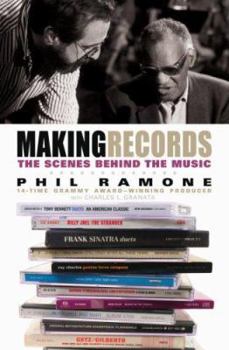Making Records: The Scenes Behind the Music
Select Format
Select Condition 
Book Overview
Sinatra. Streisand. Dylan. Pavarotti. McCartney. Sting. Madonna. What do these musicians have in common besides their super-stardom? They have all worked with legendary music producer Phil Ramone. For almost five decades, Phil Ramone has been a force in the music industry. He has produced records and collaborated with almost every major talent in the business. There is a craft to making records, and Phil has spent his life mastering it. For the first time ever, he shares the secrets of his trade.Making Records is a fascinating look "behind the glass" of a recording studio. From Phil's exhilarating early days recording jazz and commercial jingles at A&R, to his first studio, and eventual legendary producer status, Phil allows you to sit in on the sessions that created some of the most memorable music of the 20th century -- including Frank Sinatra's Duets album, Bob Dylan's Blood on the Tracks, Ray Charles's Genius Loves Company and Paul Simon's Still Crazy After All These Years. In addition to being a ringside seat for contemporary popular music history, Making Records is an unprecedented tutorial on the magic behind what music producers and engineers do. In these pages, Phil offers a rare peek inside the way music is made . . . illuminating the creative thought processes behind some of the most influential sessions in music history. This is a book about the art that is making records -- the way it began, the way it is now, and everything in between.
Format:Hardcover
Language:English
ISBN:0786868597
ISBN13:9780786868599
Release Date:October 2007
Publisher:Da Capo
Length:336 Pages
Weight:1.30 lbs.
Dimensions:1.0" x 6.5" x 9.5"
Age Range:18 years and up
Grade Range:Postsecondary and higher
Customer Reviews
2 ratings
An insiders view
Published by Thriftbooks.com User , 17 years ago
Yes, their may be issues at times with the quotes figure out if it is Phil Ramone speaking or someone else. But it is a great look into how the mind of one amazing music producer works. This book though isn't for the average reader, it is expecting you to know a lot about the background of the recording process. But for those who work in the industry this book gives great insight into how to bring the best out of musicians in the recording studio.
Compelling Glimpse Behind the Glass
Published by Thriftbooks.com User , 17 years ago
Imagine yourself facing the task of telling Tony Bennett during a recording session that, while he sounds fine, you believe he's hit a few bum notes. Not only should you have the credible acumen for identifying such flaws, but also the knowledge of how to correct them. Fortunately, Phil Ramone has an abundance of both. One of music's most prolific and distinguished producers, he candidly shares experiences from his career in his new book, Making Records: The Scenes Behind The Music. While neither a strict memoir nor a technical manual, the book blends elements of the two, usually within the context of representative and applicable anecdotes. Ramone writes an engaging account of his ascension in the music industry, from working as a studio apprentice to engineering recording sessions and ultimately producing albums and live events. As a result, the reader gains priceless insight on some landmark recordings as well perspective on the evolution of music production over the last 50 years. What makes this book such an enjoyable read is the producer's unassuming way of relating his memories and knowledge. One would suspect that someone as proficient and experienced as Phil Ramone would have, by now, lost all sense of wonder in regard to how music is made. Quite the contrary, while he undoubtedly knows what he's doing in the studio, he seems just as amazed and inspired by the creative process as any typical fan would feel. Fans of Billy Joel, in particular, will take pleasure in reading what Ramone recollects about producing many of the Piano Man's greatest albums. He recounts how certain iconic sound effects were achieved, like the shattering glass that opens "You May Be Right" and the reverberating helicopter propellers that bookend "Goodnight Saigon." He explains his view on what was lacking in Joel's first four albums -- which he didn't produce -- and why that deficiency resulted in releasing Songs From The Attic. He even divulges how he would humorously blackmail Joel and his band into working whenever they got hungry or distracted. In sharing his experiences of working with Billy Joel, Barbra Streisand, Frank Sinatra, Ray Charles, and a plethora of others, the consistent factor is how Ramone approached (and still approaches) each project with the artist's intent foremost in his mind. He astutely notes that his name doesn't appear on the covers of the albums he produces. Thus, instead of attempting to conform an artist to a certain style or standard, he respects and caters to each artist's creative goal. At the same time, Ramone justifiably points out the credentials that he brings to the making of an album. A classically trained musician in his own right, he understands music from both sides of the glass. Even when he has worked with artists who've had production experience, like Paul Simon or Paul McCartney, Ramone says that he contributed a sense of objectivity that the artists found helpful. Accommodating in his profession as well as in






